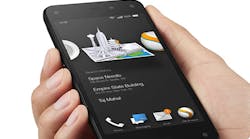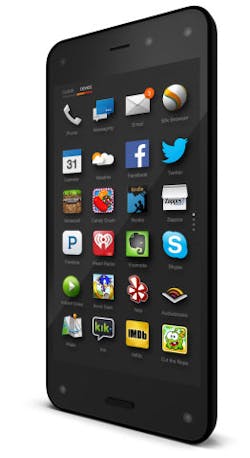Amazon just launched their much-speculated foray into the smartphone game—the Fire Phone (Fig. 1), to be sold exclusively at AT&T. Having been touted as the first 3D smartphone, there was a lot of hype…but does the phone actually live up to snuff? Here’s what they announced.
The Guts
The 4G LTE Fire Phone runs on a 2.2 GHz quad-core Snapdragon 800 CPU with an Adreno 330 GPU and 2 GB of RAM. That is on par with most of the platforms available now like the Samsung Galaxy S5 (see “Samsung Galaxy S5 – The Good, The Bad, And The Annoying”). It’s got a 4.7-in high definition LCD display with 1280 by 720 pixel resolution. That is not too great when compared to the number of 1080p phones on the market.
A 2400 mAh battery offers a reported 22 hours of talk time. It’s also Bluetooth 3.0 and NFC enabled, alongside 802.11a/b/g/n/ac Wi-Fi connectivity. The phone has its own OS—known as Fire OS 3.5—based on typical Android systems with added cloud services and with a push towards integrating Amazon’s purchasable digital content.
Dynamic Perspective
The 3D gesture control aspect of the phone, which Amazon has named Dynamic Perspective, uses a custom sensor system that responds to the way a user holds and moves the phone. Dynamic Perspective uses a set of APIs (including head tracking and motion gestures), four ultra-low power specialized cameras, four infrared LEDs, a dedicated custom processor, real-time computer vision algorithms, and a custom graphics rendering engine to track head movements.
It’s based on three main gestures: tilt, swivel, and peek. Tilt is used for panels—tilting to the left accesses the left panel to navigate menus and the tilting to the right accesses useful information and shortcuts (like attaching photos to a text message). Swivel provides access to notifications and quick actions, such as settings and the flashlight. Peek gives you added information only when you “ask” for it, such as Yelp ratings when using the Maps app to find a local restaurant.
Dynamic perspective has parallels on other phone implementations and apps. The main difference is the Fire’s head tracking of the user versus assuming its relationship to the phone from its movement.
Firefly
The phone has a specific button on the lefthand side for Firefly, which identifies everything from printed text to QR codes to songs to household items. This allows the user to save new contacts without having to type them out, recognize songs from sound bites (like Shazam) and to play related songs, and even recognizing household items and books to be ordered straight from Amazon. Firefly also uses X-ray, which is powered by IMDB, to provide more information on actors and plot details for TV shows and movies.
Firefly is the key hook for Amazon although if it is popular it is easily incorporated into other smartphones via an app.
Camera and Unlimited Storage
The Fire Phone houses a 13 MP camera with a five-element wide aperture f/2.0 lens and optical image stabilization. It captures 1080p video and uses intelligent High Dynamic Range (HDR) to merge multiple exposures into one, more detailed shot. All images and videos can be sent to the Amazon Cloud for unlimited storage given that you have an Amazon account.
One handy feature is the dedicated camera shutter button. It works even when the phone is asleep.
With the typical apps available for download—Facebook, Twitter, etc.—the Fire Phone starts at a base cost of $200. It also comes with Mayday, found on other Kindle devices, which is a free, on-device video customer service support system that is available 24/7, 365 days a year.
The real question is however, is it enough to make a dent in the iPhone and Android-soaked market? The Fire Phone does bring some new features to the mix but it remains to be seen whether these provide sufficient differentiation or advantages for users.

